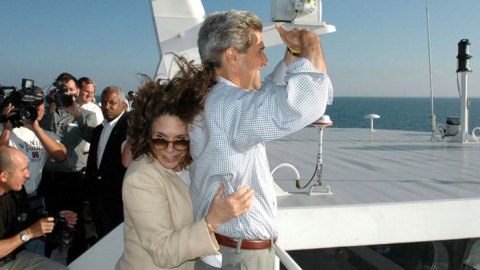With John Kerry, a quieter e-diplomacy on the horizon?

As widely expected after Ambassador Susan Rice’s withdrawal from consideration, President Barack Obama has nominated Senator John Kerry as his new Secretary of State to succeed Hillary Clinton. A new era for a quieter e-diplomacy?
Possibly quieter but certainly not less visible, or innovative.
Kerry, presently the chairman of the US Senate Committee on Foreign Relations, will face a new Department of State that Secretary Clinton has been reshaping since her very first day in office. While not without criticism and step-backs – in the wake of the September 11 incidents in Benghazi and Cairo – her 21st Century Statecraft has been a veritable diplomatic revolution: it has changed the way foreign policy priorities are actuated, while responding to the new shift of power the world has experienced, from hierarchies to citizens and networks of citizens.
“When it comes to foreign policy – this is not the most necessarily modern and agile aspect, traditionally, of American government, but under President Obama and Secretary Clinton, the State Department has harnessed social media to be a much more effective tool of our outreach,” Ambassador Rice, a Cabinet member and US Permanent Representative to the United Nations, told Pete Cashmore, Chief Executive Officer of Mashable at the 2012 Social Good Summit in New York.
The very nature of e-diplomacy and the visibility that social media have injected to the more traditional diplomatic craft are not at stake… And certainly Kerry will be transforming his State Department to better fit the legacy he wants to leave behind, even in terms of innovation and e-diplomacy.
While the US diplomatic agenda – as well as that of many other countries following in the footsteps of Hillary Clinton’s State Department – has benefited from the use of tools like Twitter and Facebook, it has also been quite visibly undermined and put to risk by these same tools. It is a balance that at Foggy Bottom they’re still trying to achieve: for instance, new rules are in the workings mainly “to recognize the dynamic and decentralized nature of the 21st century information environment,” as recently explained by deputy spokesman Mark Toner to the Washington Post.
The immediacy and visibility that characterize social media – rather than their nature – have inflated the debate over their use in diplomacy. They have made quiet diplomatic steps louder, even if unwontedly or before being official.
Kerry’s style is certainly different from that of Hillary Clinton or even Susan Rice, very close to Obama and described by many as a more natural successor to the former First Lady and Senator from New York, in particular when in comes to innovation and e-diplomacy.
Kerry is possibly quite the opposite of Rice in this respect.
“The combination of his natural ponderousness and his extreme care about secret discussions often make him maddeningly vague in public,” James Traub described Kerry in Foreign Policy article back in November 2012.
With a basin of some 240,000 followers and counting, Ambassador Rice is one of the most followed diplomats in the world, excluding Alec Ross, Clinton’s Special Adviser for Innovation, with a total of close 400,000 followers (to give a comparison, the population of Iceland is a little over 317,000, as of the 2010 census). She is also the first to use Twitter from inside closed doors at the UN Security Council in New York.
While after his presidential campaign Kerry has been quieter on Twitter and other social media, the Senator’s presence on social networks is strong with over 50,000 followers on Twitter and almost 20,000 likes on Facebook. His history on social media can be traced back to 2004, making him a great fit for Clinton’s 21st Century Statecraft agenda.
“Just two presidential election cycles ago, Facebook was only available on a handful of campuses and Twitter and Instagram were years away from existing,” Jessica Rosen wrote in the Atlantic last September. “In those heady days, one candidate, John Kerry, decided early on in the campaign to embrace the social network of the day: Friendster.”
Kerry’s team, headed by his Chief of Staff david Wade, with him since the late Nineties and very close to the 2008 Obama campaign, has been key in shaping the Senator’s social media agenda. Not surprisingly, only a few days ago, Jodi Seth, Kerry’s communications director since 2009, joined Facebook’s office in Washington DC as manager for public policy and communications, as reported by Mediabistro.
Senator Kerry will certainly be able to look beyond social media and technology, and focus his attention to the true nature of e-diplomacy, and that is innovation and the power of ideas. Being quieter or instituting a different approach is not what will change America’s e-diplomacy agenda.
The direction that a new era of e-diplomacy will take is too early to predict, but e-diplomacy is here to stay, under Kerry and certainly any future successors, Democrats and Republicans alike. Quite interestingly, Kerry will be the first Secretary of State with his own Twitter account, as Clinton uses the official profile @StateDept and she’s referred to as #SecClinton. Let’s see how Secretary Kerry will put Twitter to good use.





